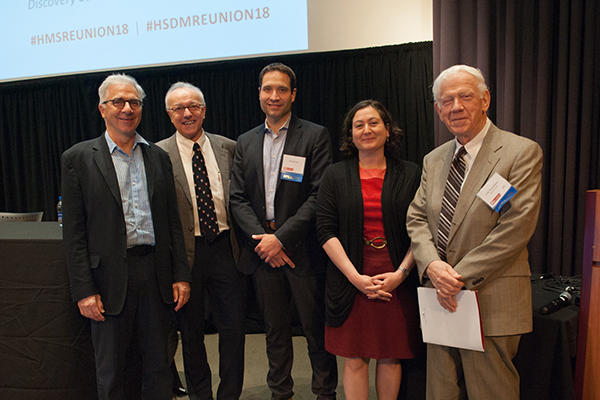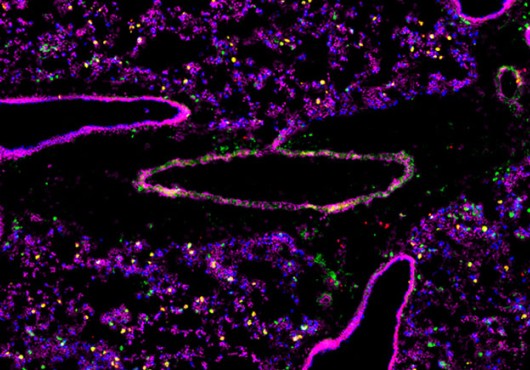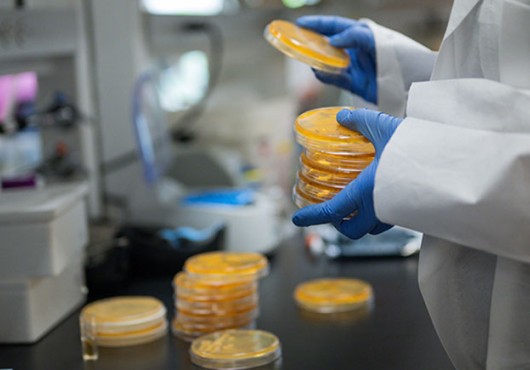
Growing replacement organs? Reengineering a patient’s own cells to erase disease? Guiding stem cells to replenish injured or aging tissues?
Once a far-off dream, regenerative medicine is rapidly becoming a reality.
On May 31, Harvard Medical School and Harvard School of Dental Medicine alumni gathered in the Joseph B. Martin Conference Center to celebrate the community’s latest achievements along the path toward using stem cells to repair tissues and treat disease.
The scientific symposium “Discovery at HMS: Regenerative Biology,” featuring four keynote speakers, took place during Reunion 2018, a three-day program for visiting HMS/HSDM alumni. A.W. Karchmer, MD ’64, chair of Alumni Relations at HMS, moderated the event.
“There’s no better time than now to pursue regenerative medicine research; no better city than Boston; and no better dean for HMS than George Q. Daley,” said Douglas Melton, the Xander University Professor at Harvard University.
“You are at the world’s epicenter of thinking about whether and how to use the power of cells to treat disease,” Melton said.
Blood from a petri dish
Daley, MD ’91, described the odyssey he and other scientists have undertaken over the past 20 years to engineer human blood stem cells that share all the properties of natural blood stem cells.
“I’m dean, but I’m still masquerading as a scientist,” said Daley, also the Caroline Shields Walker Professor of Medicine at HMS.
“One of the hardest decisions I had to make in taking on the role was to back away from a decades-long career in science and a decades-long struggle to get to where I will describe today, a place where we’re tantalizingly close to realizing how to transform the future of bone marrow transplantation,” he said.
Daley said he was initially motivated by seeing patients with chronic myeloid leukemia who weren’t eligible for bone marrow transplantation or did not have matching donors.
“I set out with the goal of using stem cell biology to create a universal donor stem cell that would not trigger immune system attacks in patients,” he said. “The real goal was to make stem cells from every individual who might need it, so we all might become our own donors.”
Daley and others in the field have since expanded their efforts into engineering platelets, red and white blood cells, and T and B cells.
The results could help researchers to better model human diseases and could also lead to new treatments for primary immune deficiency, bone marrow failure, hemoglobin disorders such as sickle cell disease, cancer and more, Daley said.
Already, Daley and his collaborators have used stem cells derived from patients with Diamond-Blackfan anemia to discover potential new drugs for the disease.
“We hope that is the first of many successes,” Daley said.
As scientists make strides in coaxing induced pluripotent stem (iPS) cells to differentiate into specialized blood cell types, attention has been turning to lowering costs and scaling up.
Cancer immunotherapies such as CAR-T cell therapies, for example, “have been startlingly successful for certain pediatric and adult cancers, but they come with staggering price tags,” said Daley. “If we could make T cells from stem cells, we could skip the patient-specific approach and drive the price down considerably.”
“We can harness iPS cells,” Daley continued. “This is coming down the pike and will revolutionize and ultimately democratize CAR-T cell therapy.”

No more injections: Transforming diabetes treatment with cellular therapy
Melton described his laboratory’s efforts to turn human stem cells into functional, insulin-producing pancreatic beta cells that could one day be used to treat diabetes.
Such an achievement would provide patients with better blood-sugar control than current glucose monitoring and insulin injection techniques for patients who don’t have enough beta cells, such as those with type 1 diabetes or who have had their pancreas removed, Melton said.
Melton described how his group has learned to produce functional beta cells in the lab. He showed video footage of a tray of flasks, each of which brews enough beta cells to treat a person, he said.
The team is now “fiddling with the protocol” to see if they can better control the cell types they grow and their efficiency. Even at this point, however, Melton’s group is confident enough in their findings to move into clinical trials to test whether the cells will function as expected and are not harmful.
Melton said that the lab-grown beta cells promise to solve two challenges posed by islet cell transplantation, an experimental treatment for type 1 diabetes in which patients receive insulin-producing cells from the pancreas of a deceased donor.
First, Melton said, his lab’s technique should be able to produce enough beta cells to alleviate the global donor shortage. Second, he said, while current islet cell transplants require lifelong immune suppression, a company he founded is working to wrap the lab-grown cells in a permeable material that would let critical hormones such as insulin pass through while shielding the cells from immune detection.
“Nothing tells me it won’t be possible to conquer the problem of making an unlimited supply of functional human islets,” Melton said. “It’s possible to change the course of diabetes by using cells rather than insulin.”
Moving towards the regeneration of joints
April Craft, assistant professor of orthopedic surgery at HMS and Boston Children’s Hospital, described her lab’s and others’ efforts to engineer stem cells that repair damaged and degenerating cartilage.
Current treatments for cartilage problems often have shortcomings, Craft said, such as reducing pain but not improving function, a lack of certain biochemical and biomechanical properties of normal cartilage, or being able to heal only small injuries. She said she believes stem cell therapies could overcome these constraints.
The journey, however, has not been easy. Craft said some stem cells have made cartilage well in lab dishes, only to turn into bone when tested in mice. Successful stem cell engineering not only must produce the right types of cartilage cells but also needs to integrate well with the existing cartilage in a patient’s joint, look and function like normal cartilage, avoid immune attack, come from a “robust and renewable” source and more, she said.
So far researchers, including Craft, have been able to direct stem cells to grow articular cartilage, which makes joints glide smoothly, and growth-plate cartilage, which allows bones to grow longer, in animal models. They are moving into preclinical studies to see whether human clinical trials are feasible.
“We know what cartilage cells we have to make, and we know where the stem cells are, so [it’s a question of] how do we get there,” said Craft. “For that, we can use developmental biology as a guide.”
As they advance regenerative medicine for cartilage, Craft said she hopes that learning more about stem cell differentiation and normal developmental biology will also help the field make strides in generating meniscus, ligament and tendon tissues.
Growing organs on demand
Harald Ott, associate professor of surgery at HMS and a thoracic surgeon at Massachusetts General Hospital, reviewed his lab’s progress in regenerating whole organs for transplantation.
“Organ failure is a global problem that will affect many of us,” he said. “Living tissue and organ grafts provide a sustainable solution, and adult-derived stem cells provide an unlimited supply of personalized building blocks for these tissues.”
Medicine has evolved to the point where millions of people each year survive heart attacks, strokes and other acute health crises and chronic conditions but now face organ failure and a shortage of donor organs, Ott said.
He and others are tackling the problem by looking at human organs as “biologic devices” that can be replicated through a combination of regenerative biology, engineering and surgery.
Replacement organs don’t even need to be perfect at this stage, Ott said, so long as they perform their basic functions and improve patients’ quality of life.
Ott described his group’s core strategy: build or obtain a scaffold for the organ, seed it with living cells, coax it through a tissue-assembly process to form a 3D structure and transplant it into an organism.
One way to build a scaffold is to use a technique Ott developed called perfusion decellularization, in which an organ from a cadaver or other organism is washed clean of cells and other materials, leaving only the semi-transparent extracellular matrix behind.
Ott also walked the audience through the process needed to direct stem cells to become the appropriate kinds of cells to populate those organ scaffolds.
He then outlined a method called directed morphogenesis, which hastens the generation of the 3D organ structures. The hope, he said, is that it wouldn’t take months to grow an organ for a patient whose health is rapidly failing.
In closing, Ott shared recent successes in biofabricating lungs, and parts of lungs, that can perform gas exchange. Tests in animal models have been promising, he said.
Looking to the future, Ott said he envisions even better-performing replacement organs that can grow with young patients and survive challenges such as infection with the flu.
Whereas the first generation of such organs are made of tissue grafts built on natural platforms, the second generation might be more advanced fabrication inspired by nature, he said.
A packed Reunion program
The scientific symposium was held alongside the Class of 1993 25th Reunion Symposium, “Medicine 2.0: The Fourth Aim, Finding Joy.” That program featured four panels focusing on joy in discovery, teaching and mentorship, healing and caring, and “beyond medicine.”
Formal Reunion programming continued on June 1 with the Harvard Medical Alumni Association Annual Business Meeting; the HMS Alumni Day Symposium “Advances in Medicine: It Takes a Biomedical Village”; the HSDM Alumni Day Symposium “Oral Health on a Global Scale”; and the HMS and HSDM State of the School addresses.





